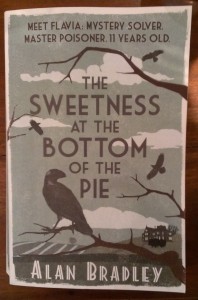Review
The Sweetness at the Bottom of the Pie
by Alan Bradley
I bought this book almost entirely based on its cover, so I wasn’t expecting much to be honest. Although it was on the shelf next to the next three books in the series, which suggests that it was good enough to have sequels, but as it was the shelf of an op-shop, not good enough to be kept. All the books in the series were in very good condition, so I’d be surprised if they’d been read more than once, if at all.
Set in England in 1950, 11 year old Flavia de Luce lives in a rambling old mansion with her stamp-obsessed father, two sisters (relationship- and book- obsessed respectively), and her father’s PTSD-affected dogsbody from the war. Flavia is herself obsessed with chemistry. The sisters’ mother was killed in a mountaineering accident when Flavia was a baby, a mysterious accident which I imagine might be investigated further in subsequent books. So far, so quirky. Then one morning a dead bird is discovered on the kitchen doorstep with a stamp impaled on its beak. What follows is a fairly humdrum detective story, which involves a significant amount of frantic cycling to the village and surrounding countryside to chase up clues, and an incredibly patient police detective.
Two things struck me most about this book. First, there are some amazing similes which pop up now and then, like this one:
There was a rumble in the distance as the Cottesmore bus approached, waddling along the lane between the hedgerows like a chicken walking a tightrope (p.156).
And this one:
In a tree across the road, a solitary rook shook itself out like a wet umbrella (p.166).
The other feature that stuck out was the detail given over to explaining things which aren’t relevant to the story, but which do flesh out the context. Whenever someone reads a book, it is named with both title and author, a man doesn’t just smoke a cigarette, he smokes a Players cigarette and then there is this:
… torrents of sunshine, diffused by endless swags of Italian lace, into a chamber that might have been a stage-setting for a play about the Duke and Duchess of Windsor. The dresser-top was laid out with brushes and combs by Fabergé… Lalique scent bottles were ringed with colourful bracelets of Bakelite and amber… (p.141)
That’s a description of Flavia’s mother’s dressing table, although it sounds to me like a gushy house-visit in a magazine. I’m not sure whether the detail is excessive, or whether it would be useful to someone who had little knowledge of 50’s England. Either way, I think the proliferation of historical details can partly be explained by Bradley’s admission in the endnote that he hadn’t even been to England when he wrote The Sweetness at the Bottom of the Pie, but had grown up with grandparents who had a vast collection of English books and magazines, which caused his younger self to create “in my mind, my own private England; not, perhaps, as it was in reality, but as it should have been” (Reading Group Notes, p.6).
Overall, I wasn’t particularly impressed by The Sweetness at the Bottom of the Pie, but I’ll be the first to admit that I’m not fond of child narrators, precocious children or conveniently incompetent police forces (although my love of Agatha Christie novels proves me a massive hypocrite on the last point). It was a well-written book, the plot was probably of a Sunday night, Midsomer Murders standard, but it just didn’t grab me. Suffice it to say, I will be returning the book to the op shop whence it came, and will not be reading the sequels.

